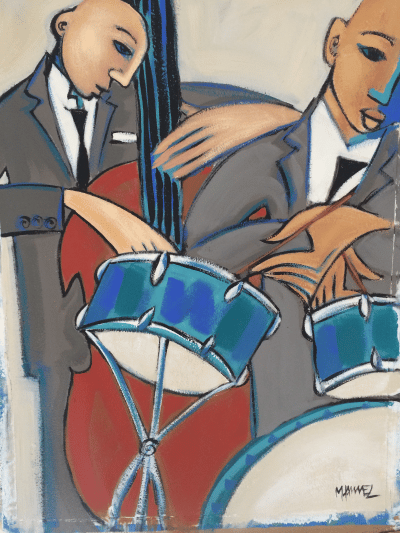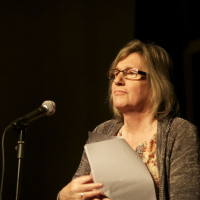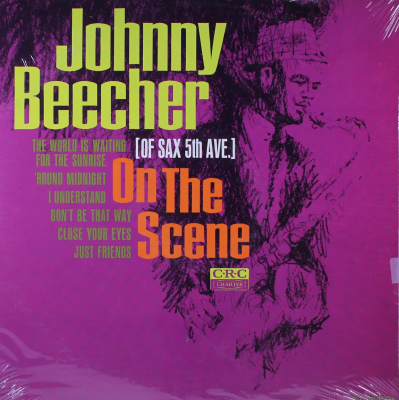.
.
“The Bottom,” by Marsha Hammel

.
.
Room 414
………………..(For Robert Johnson)
November 23rd, 1936,
the man who’d sold his soul
at the crossroads
for a guitar and a pick
rolled into ole San Antone,
steel guitar in hand,
checked into the Gunther,
his soon to be promised land.
Three days he wailed
and strummed,
his back to the room,
recorded sixteen songs
– mournful and true –
the blues of a ramblin’ man
with the hounds of hell
doggin’ his trail.
He invited one and all
to come into his kitchen
and stop a spell,
listen to the voices on the wind,
the soft, gentle murmurs
of regret and pleas for redemption.
On and on,
he sang of woes,
kindhearted women,
and his sweet Chicago home,
the walkin’ blues
of a lonesome rollin’ stone.
He finished his dirge,
packed up his case,
moved on down the road
toward his final resting place.
Somewhere in Mississippi,
three tombstones mark his graves,
but in ole San Antone
his soul remains,
wailin’ the blues in room 414,
trapped in a ramblin’ man’s purgatory,
all ‘cause he sold his soul at the crossroads
for a pick, guitar, and short-lived fortune.
.
by Antoinette Winstead
.
___
.
Concert
At the piano, her head lolling back
over her shoulders into the waters
of Beethoven (like the otter beneath
the bridge yesterday, barely visible,
swimming on its back below the creek’s
surface with stunning grace, generating
ripples in every direction), the pianist’s
fingers ripple over keys with mathematic
precision like the soft rain yesterday
with its gentle intensity falling on
the creek below where I stood rapt,
where otter and heron (one gliding,
the other motionless save for
occasional forays of the head beneath
the surface) married elegance and swift
motion into figures which defined
the landscape, just as the pianist wove
speed, grace, and accuracy into waves
of sound whose currents surged, some
mightily, some softly, in multiple directions
while all remained part of a great liquid
tapestry, ever shifting and reforming and
shifting again, yet moving inexorably
toward a coming together which blended
all into one; when she approached the mighty
climax, her head fell forward and her
whole body convulsed, as the music
exploded into silence, and the audience
exploded into sound, and then all was silent,
silent as a creek flowing beneath a bridge
where a soft rain fell in blessing on all life
above and below the quietly flowing stream.
.
……….(previously published in Meditation of an Old Man Standing on a Bridge (Bellowing Ark Press, 2019)
.
by Michael L. Newell
.
___
.
Ornette Coleman Morning
Early…
waiting with my wife
for a family visit –
playing joyful music,
the original Ornette Coleman Quartet,
makes my soul dance and feet tap
the shape of jazz to come
sounds like madness to some.
a freezing rain that delays us all morning
slowly melts on wet highways
before we drive through the stormy Catskills.
Ornette is like weather –
fear, anger, disappointment
change of plans, dismantling
of landscapes,
or acceptance
of something else
enough change for a century –
knowing the sun will
melt adversity
light will dance in your being
tap your toes
answering tomorrow’s questions…
.
by Dan Brown
.
___
.
Lessons In Love
………………..(For Duke Fakir, Four Tops)
You loved everything you touched
and the love came right back atcha
right from the get go
right from that giddy up yap
told it like it was, is and always will be
a hundred funk brothers and sisters
got your back
and you ask me can they play?
the cream of Detroit jazz
and the whole damn symphony string section
(weren’t no snakes in that snakepit)
those anthems, those lessons in love
and your momma
no more cleaning house for white folks
no more washing clothes
no, you no need to never work a day
now you can get off of your damn knees
ten thousand dollars says Berry has a heart
ten thousand dollars says he got soul
ten thousand reasons not to love him
but we did
and she did
what is the sound of young america
it’s the sound of love
it’s the sound that rebounds around the world
songs that are more than just nice notes
on the assembly line of truth
they sang
either side of the washing line
they sang
they sang the truth when they born
they sang the truth when they die
we sang “you can’t be happy
until you love someone”
for sixty eight years
and the whole world loved us
and we still singing.
.
by Isabel White
.
___
.
All The People Were Singing
Yes, The Band’s broken-voice lament
for Virgil Caine, I bought it. Many’s the time
I homespun it, 45 rpm on the family turntable.
“Up on Cripple Creek” got airplay, but its B-side
lured me to the record store. There went Robert E. Lee,
and that was sorrowful because old Dixie’d
been driven down. Tracks torn up, barely alive.
I compassionated in my mind with the poor white
whose brother was laid in his grave by a Yankee.
In defeat. In 1969, this was just history. All done.
Old mud beneath Dixie’s feet.
………………………………………………………….Maybe Joan Baez
felt the same. Her cover launched Robbie Robertson’s
lost-cause plaint to the head of the charts,
eight years after she bathed the Lincoln Memorial
with “We Shall Overcome.” Because sure we’d
overcome, not some day but almost now.
I sang the song in church camp enough times
to be certain of that. We could cast side-eyes
at those scattered skulk-types snarling
under their respective rocks. They were
perishing. Mad Magazine guffawed at the Klan.
So did I.
………………….We Great Society kids had belted “Dixie”
in elementary music hour, without a cringe.
We didn’t really wish we were in the land of cotton.
It was old-timey Americana, like “Oh Susanna.”
Or “Old Black Joe.” I hadn’t the least notion
that when Lee bid his affectionate farewell
to the Army of Northern Virginia,
that was only a strategic pause. I thought
it meant the war had ended way back then.
.
by David P. Miller
.
.
_____
.
.
Michael L. Newell lives in Florida. He has had seven books of poetry published in the last three years.
.
.
___
.
.

Antoinette F. Winstead is a poet, playwright, director and actor living in San Antonio, Texas, where she’s a professor at Our Lady of the Lake University. Her poetry has appeared in several publications, including Voices de la Luna, Langdon Review, Texas Ballot Poetry, Tejas Covido, and The Poet Magazine. She is currently serving as the 2021-2022 Writer in Residence for the Carver Community Cultural Center in San Antonio, Texas. She was nominated for the 2022 Pushcart Prize by Jerry Jazz Musician for her poem “Life Is…“
.
.
___
.
.

Daniel Brown has loved jazz (and music in general) ever since he delved into his parents’ 78 collection as a child. He is a retired special education teacher who began writing as a senior. He’s content to write with the sunrise each day and always appreciates being published in a journal or anthology. His first poetry collection Family Portraits in Verse is forthcoming.
.
.
___
.
.

Isabel White has performed across the UK, at Shakespeare & Co in Paris and in Rotterdam. She was twice runner up in the BBC Radio 3 Proms Competitions; a finalist in nine others and poet-in-residence for organizations working with marginalized communities. With three full collections and a pamphlet under her belt, Isabel’s poetry has been widely published – in 18 books and journals to date. Isabel founded performance collective Alarms and Excursions in 2009, www.alarmsandexcursions.com
.
.
___
.
.
David P. Miller’s collection, Bend in the Stair, was published by Lily Poetry Review Books in 2021. Sprawled Asleep was published by Nixes Mate Books in 2019. His poems have appeared in Meat For Tea, Denver Quarterly, The Poetry Porch, Subterrain, Muddy River Poetry Review, Constellations, Lily Poetry Review, Caustic Frolic, Clementine Unbound, and Nixes Mate Review, among others. He lives with his wife, the visual artist Jane Wiley, in Jamaica Plain, Massachusetts.
.
.
___
.
.

A native of Miami, FL, Marsha Hammel grew up in Central America and Europe, returning to the states in 1961. A prolific artist, she enjoys a wide audience for original paintings and published works in the UK, having been represented by Felix Rosenstiel’s in London since the early 90’s. During a four-decade studio practice, at least 1500 paintings have become part of private, corporate and institutional collections throughout the US and Europe. Click here to visit her website.
.
.
_____
.
.
Click here to learn how to submit your poetry
Click here to subscribe to the Jerry Jazz Musician quarterly newsletter
.
.
.
































